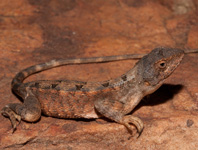Abstract
Mygalomorphs are a diverse spider group with primitive characteristics composed of the largest spider species in the world, however some species may be very small (Bond et al. 2012; Rogerio et al. 2013). The small spiders of the subfamily Masteriinae (Dipluridae, Mygalomorphae) can be found in Asia and South America (Raven 1981; Pedroso et al. 2015; WSC 2017). The subfamily is represented by two genera: Masteria L. Koch, 1873 and Striamea Raven, 1981. Masteria species can be identified by the following combination of characters: absence of cuspules in endites and labium; zero, two, six or eight eyes; and with or without paraembolic apophysis on the male palpal bulb (Raven 1981, 1985, 1991; Alayón 1995; Bertani et al. 2013; Pedroso et al. 2015). Currently, 24 species of Masteria are described, with 6 species found in South America: Masteria colombiensis, Raven, 1981 from Colombia; M. manauara Bertani, Cruz & Oliveira 2013 and M. emboaba Pedroso, Baptista & Bertani, 2015 from Brazil; M. cyclops (Simon 1889), M. tovarensis (Simon, 1889) and M. lucifuga (Simon, 1889) from Venezuela (WSC 2017). We document herein the first record and description of a new species of the genus Masteria from Guyana.
References
Alayón, G.G. (1995) La subfamilia Masteriinae (Araneae: Dipluridae) en Cuba. Poeyana, 453, 1–8.
Bond, J.E., Hendrixson, B.E., Hamilton, C.A. & Hedin, M. (2012) A reconsideration of the classification of the spider infraorder Mygalomorphae (Arachnida: Araneae) based on three nuclear genes and morphology. PLoS ONE, 7, e38753. https://doi.org/10.1371/journal.pone.0038753
Bertani R., Cruz W.R. & Oliveira M.E.E.S. (2013) Masteria manauara sp. nov., the first masteriine species from Brazil (Araneae: Dipluridae: Masteriinae). Zoologia, 30 (4), 437–440.
https://doi.org/10.1590/S1984-46702013000400010Koch, L. (1873) Die Arachniden Australiens. Nürnberg, 1, 369–472.
Pedroso, D.R., Baptista, R.L.C. & Bertani, R. (2015) A new species of Masteria (Araneae: Dipluridae: Masteriinae) from southeastern Brazil. Zoologia, 32 (1), 59–65.
https://doi.org/10.1590/S1984-46702015000100009Raven, R.J. (1981) Three new mygalomorph spiders (Dipluridae, Masteriinae) from Colombia. Bulletin of the American Museum of Natural History, 170, 57–63.
Raven, R.J. (1985) The spider infraorder Mygalomorphae (Araneae): Cladistics and systematics. Bulletin of the American Museum of Natural History, 182, 1–180.
Raven R.J. (1991) A revision of the mygalomorph spider family Dipluridae in New Caledonia (Araneae). In: Chazeau, J. & Tillier, S. (Eds.), Zoologia Neocaledonica. Mémoires du Museum National d’Histoire Naturelle (A), 149, 8 –117.
Simon, E. (1889) Arachnides. In: Voyage de M.E. Simon au Venezuela (décembre 1887-avril 1888), 4e Mémoire. Annales de la Societe Entomologique de France, 9, 169–220.
World Spider Catalog (2017) World Spider Catalog. Natural History Museum Bern. Available from: http://wsc.nmbe.ch, version 18.5 (accessed on 14 August 2017)

